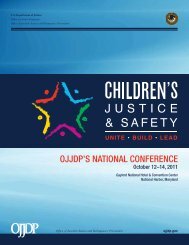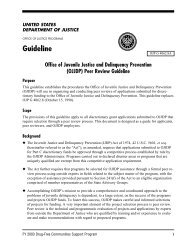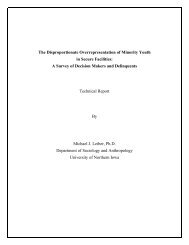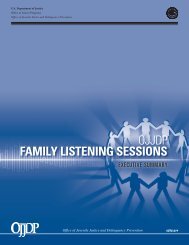Promising Strategies To Reduce Gun Violence - Office of Juvenile ...
Promising Strategies To Reduce Gun Violence - Office of Juvenile ...
Promising Strategies To Reduce Gun Violence - Office of Juvenile ...
You also want an ePaper? Increase the reach of your titles
YUMPU automatically turns print PDFs into web optimized ePapers that Google loves.
The Nature <strong>of</strong> the Problem<br />
and Current Trends<br />
In 1996 (the most recent year for which data are<br />
available), 34,040 people died from gunfire in the<br />
United States. Of these deaths, approximately 54<br />
percent resulted from suicide, 41 percent resulted<br />
from homicide, and 3 percent were unintentional<br />
(see figure 2). Firearm injuries are the eighth leading<br />
cause <strong>of</strong> death in the United States. In addition,<br />
for every fatal shooting, there are roughly three<br />
nonfatal shootings. 1<br />
<strong>Gun</strong>-related crime peaked in the late 1980’s and<br />
early 1990’s. Since that time, the United States has<br />
made steady improvement in reducing gun-related<br />
violence (see figure 3). <strong>Gun</strong>-related homicides have<br />
declined by 33 percent since 1993, including a 35-<br />
percent drop in handgun homicides. Meanwhile,<br />
from 1992 to 1996, murder rates declined by 20<br />
percent, aggravated assaults by 12 percent, and the<br />
overall violent crime rate by 16 percent. 2 The Federal<br />
Bureau <strong>of</strong> Investigation’s (FBI’s) Uniform Crime<br />
Report data for 1997 show that these trends are continuing,<br />
with murder and robbery totals declining by<br />
7 percent over the previous year and the total <strong>of</strong> all<br />
violent crimes declining by 3 percent. 3 Nonetheless,<br />
gun violence remains a serious national problem.<br />
The impact <strong>of</strong> gun violence is especially pronounced<br />
among juveniles and adolescents. The firearm homicide<br />
rate for children under 15 years <strong>of</strong> age is 16<br />
times higher in the United States than in 25 other<br />
industrialized countries combined. Among those<br />
ages 15 to 24, the U.S. firearm homicide rate is<br />
5 times higher than in neighboring Canada and<br />
30 times higher than in Japan, and the firearm<br />
homicide rate for the 15- to 24-year-old age group<br />
increased 158 percent during the 10-year period<br />
from 1984 to 1993 (see figure 4). This contrasts with<br />
a 19-percent decline in gun-related homicides for<br />
those 25 and older. A teenager in the United States<br />
today is more likely to die <strong>of</strong> a gunshot wound than<br />
from all the “natural” causes <strong>of</strong> death combined. 4<br />
the leading cause <strong>of</strong> death for African-American<br />
males ages 15 to 19 since 1969. 5<br />
Figure 2. 1996 Firearm Deaths by Intent<br />
41%<br />
<strong>To</strong>tal Deaths for All Ages<br />
N=34,040<br />
3% 2%<br />
<strong>To</strong>tal Deaths Ages 14 and Under<br />
N=693<br />
2%<br />
20%<br />
23%<br />
29%<br />
<strong>To</strong>tal Deaths Ages 15–19<br />
N=3,950<br />
6% 3%<br />
54%<br />
55%<br />
62%<br />
Young African-American males have the most elevated<br />
homicide victimization rate <strong>of</strong> any race or gender<br />
group. Homicides involving firearms have been<br />
Suicide<br />
Unintentional<br />
Homicide<br />
Other<br />
Section I: <strong>Gun</strong> <strong>Violence</strong> in the United States 3



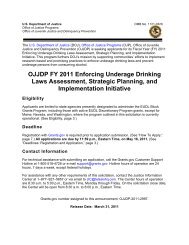

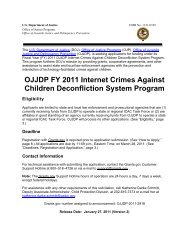
![Chapter 5 [PDF] - Office of Juvenile Justice and Delinquency ...](https://img.yumpu.com/46584340/1/190x245/chapter-5-pdf-office-of-juvenile-justice-and-delinquency-.jpg?quality=85)




